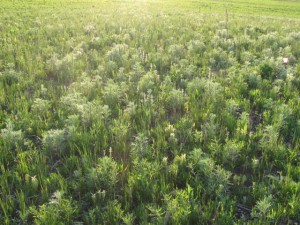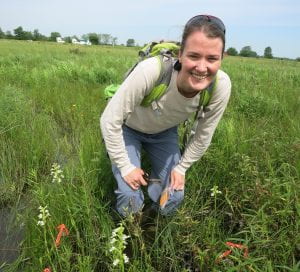Restorations
Choosing “genetically appropriate material” for restoration has become an important aim of many restorations.
Restorations genetics is a relatively new field. There is still a lot we do not know about what makes for a successful restoration. Genetic diversity is just one piece of the puzzle but can have important implications for restoration success.
My lab’s research is focused on:
- What are the potential genetic changes in the production of restoration material and how does this impact the restorations?
- Current Members: Fernando Rocha Vento (PhD)
- Past Members : Claire Ellwanger (MS, 2017), Adrienne Basey StClair (MS 2015), Ben Staehlin (MS 2009),
- Choosing genetically appropriate material is an important component of many restorations. Rare species can offer many challenges when trying to achieve this aim.
- Current Members: Marne Quigg (MS current)
- Past Members: Chris Woolridge (MS 2017, co-advised with AK); Abigail White (MS 2016, co-advised with AK), Evelyn Webb Williams (Postdoc 2014)
- Genetic Augmentation is increasingly been seen as a means to improve the state of depauperate and declining populations
- Current Members: Rafael Urbana Casanova (PhD)
- Past Members: Nora Gavin Smyth (MS, 2018).
Media
-
-
- Iris
- Golden Paintbrush
- Fringed Orchid
- Genetic augmentation – video from CPC (Nora)
-
Publications (± = Postdoc,+ = PhD Student,++ = MA Student, * = Undergraduate Student,# =Citizen Scientist)
- Bellis J., O Osazuwa‐Peters, J Maschinski, MJ Keir, EW Parsons, TN Kaye, … (2003) Identifying predictors of translocation success in rare plant species Conservation Biology
- Diaz-Martin Z±, J Fant, K Havens, W Cinea, JMT Lima, MP Griffith (2003) Current management practices do not adequately safeguard endangered plant species in conservation collections. Biological Conservation 280, 109955 5
- Li B.++, J.B. Fant, J Zeldin, K Skogen, K Havens. 2023. Genetic and floral trait changes in Oenothera organensis (Onagraceae) during long-term ex situ cultivation. International Journal of Plant Science (in press).
- Woolridge, Christopher B. ++, J.B. Fant, Ana I. Flores, Kelly Schultz, and Andrea T. Kramer. 2023. “Variation in Overall Fitness Due to Seed Source: Projections for Predictive Provenancing.” Restoration Ecology 31 (1), e13717. https://doi.org/10.1111/rec.13717.
- Vitis, Marcello De, Kayri Havens, Rebecca S. Barak, Louise Egerton-Warburton, Adrienne R. Ernst+, Matt Evans++, J.B. Fant, et al. 2022. “Why Are Some Plant Species Missing from Restorations? A Diagnostic Tool for Temperate Grassland Ecosystems.” Frontiers in Conservation Science 3. https://doi.org/10.3389/fcosc.2022.1028295.
- Gavin-Smyth, N., Kramer, A. T., Urbina-Casanova, R., Vitt, P., & Fant, J. B. (2021). Genetic rescue reduces mate limitation in a threatened, clonal, and self-incompatible plant species. Restoration Ecology, 1–9. https://doi.org/10.1111/rec.13458
- Kucera, K.F.++, J.B. Fant, S. Jensen, M. Landeen, E. Orr*, A.T. Kramer (2021) Genetic variation and structure change when producing and using mixed‐source seed lots for restoration. Restoration Ecology, e13521
- St. Clair, A. B. ++, Dunwiddie, P. W., Fant, J. B., Kaye, T. N., & Kramer, A. T. (2020). Mixing source populations increases genetic diversity of restored rare plant populations. Restoration Ecology, 1–11. https://doi.org/10.1111/rec.13131
- Flower, C.E., J.B. Fant, S. Hoban, K.S. Knight, L. Steger, E. Aubihl, M.A. Gonzalez-Meler, S. Forry, A. Hille, and A.A. Royo (2018) Optimizing Conservation Strategies for a Threatened Tree Species: In Situ Conservation of White Ash (Franxinus Americana L.) Genetic Diversity through Insecticide Treatment. Forests 9 (4) 202-
- White, A++, J.B. Fant, K. Havens, M. Skinner, and AT. Kramer (2018) Restoring species diversity: assessing capacity in the US native plant industry. Restoration Ecology Vol. 26, No. 4, pp. 605–611
- Hunt, V.M.+, J.B. Fant, L. Steger, P.E. Hartzog+, E.V. Lonsdorf, S.K. Jacobi and D.J. Larkin (2017) PhragNet: crowdsourcing to investigate ecology and management of invasive Phragmites australis (common reed) in North America. Wetlands Ecol Management 25 (5): 607-618
- Fant J.B., Price, A.++ and D. Larkin (2016) The influence of habitat disturbance on genetic structure and reproductive strategies within stands of native and non-native Phragmites australis (common reed)” Diversity and Distributions. 22 (12) Pages 1301–1313.
- Barak, R. S.++, J. B. Fant, A. T. Kramer, and K. A. Skogen. (2015). Assessing the value of potential “native winners” for restoration of cheatgrass-invaded habitat. Western North American Naturalist 75(1) 58-69.
- Basey A.++, J.B Fant, A.T. Kramer (2015) Producing native plant materials for restoration: ten rules to collect and maintain genetic diversity. Native Plants Journal 16:37-53.
- Havens K., P. Vitt, S. Still, A.T. Kramer, J.B. Fant, and K. Schatz (2015) Seed Sourcing for restoration in an era of climate change. Natural Areas Journal 35(1) 122-133
- Kramer A.T., D Larkin and J.B. Fant, (2015) Assessing potential seed transfer zones for five forb species from the Great Basin floristic region, U.S.A.. Natural Areas Journal 35(1) 174-188
- Staehlin B++. & J.B. Fant (2015) Climate change impacts on seedling establishment for a threatened endemic thistle. The American Midland Naturalist 173(1):47-60. 2015
- Herman B, S Packard, Cathy Pollack, G. Houseal, S. Sinn, C. O’Leary, J. Fant, A.D. Lewis, S. Wagenius, D. Gustafson, K. Hufford, Bob Allison, K. Shaw, S. Haines and C. Daniels (2014). Decisions… Decisions… How to Source Plant Material for Native Plant Restoration Projects. Ecological Restoration 32 (3) 236-238.
- Overholt, W. A., M. P. Sowinski, D. C. Schmitz, J. Schardt, V. Hunt, D. J. Larkin, and J. B. Fant. 2014. Early detection and rapid response to an exotic Phragmites population in Florida. Aquatics 36:5-7.
- Price, A.++, J.B. Fant and D. Larkin (2014) Ecology of native vs. exotic Phragmites australis (common reed) in Chicago-area wetlands. Wetlands 34 (2) 369-377
- Fant, J.B., A.T. Kramer , E. Sirkin# and K. Havens (2013) Genetics of reintroduced populations of the narrowly endemic thistle, Cirsium pitcheri (Asteraceae). Botany 91 (5) 301-308)
- Fant, J.B., A. Banai++, K. Havens and P. Vitt (2010) Morphological and molecular evidence of hybridization between the federally threatened Lespedeza leptostachya Englem. and its co-occurring congener Lespedeza capitata Michx. Conservation Genetics 11 (6) 2195-2205
- Maschinski J., E. Sirkin# and J.B. Fant (2010) Using Genetic and Morphological Analysis to distinguish endangered taxa from their hybrids with the cultivated exotic pest plant Lantana strigocamara (syn: Lantana camara) Conservation Genetics 11 (5) 1607-1621
- Fant, J.B., R.M.Holmstrom++, E. Sirkin#, J.R. Etterson, and S. Masi (2008) Genetic structure of threatened native populations and propagules used for restoration, in a clonal species, Ammophila breviligulata (American beachgrass). Restoration Ecology 16 (4) pp. 594-603.





